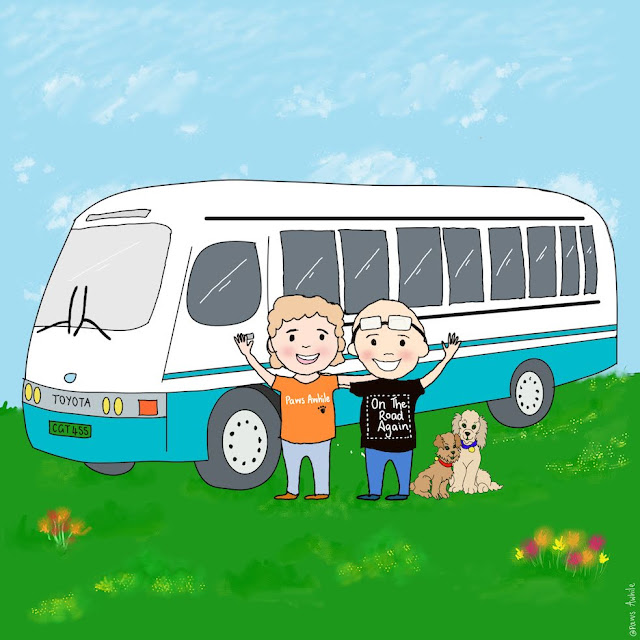Ward Beach is a wild, deserted beach with interesting rock formations about 50kms south of Blenheim. Bernie and I have stayed there before and were looking forward to spending a weekend relaxing with the dogs.
Once parked we opened the back doors of the bus to be rewarded with magnificent ocean views.
Oakly found an ideal spot. Lying on the bed he had the perfect view to watch and wait for any sign of movement.
Beside the bus, beneath a large macrocarpa tree is a pile of decorated stones. Previous campers have left a memento of their Ward Beach visit.
As the sky darkened, it looked like the forecasted rain wasn't far away, so we set off for a walk before the weather closed in.
Old tide marks on the rocks show the rise of the sea bed due to the 7.8 magnitude earthquake in 2016.
Due to fault movement the change in the seabed level has had a big impact on local commercial fishing. Before the earthquake several crayfishing boats were launched from Ward Beach with the aid of bulldozers. Nowadays it's not as busy because the Environment Court issued an injunction order to stop fishing companies from launching off the beach. This was due to the concerns of Forest and Bird that bulldozers dragging boats would disrupt the habitat of the banded dotterel and the variable oyster catcher.
From a distance it looked as though white paint had been splattered across some rocks. These white markings are what's left of the kelp and sea life which were once attached to rocks before the coastline was uplifted. Now that the remains have rotted away all that's left behind is a white substance.
The different rock formations make great photo subjects. Not only is it a great place for photographers and sight seers, I'm sure geologists would enjoy this area too.
Just a short walk from the Ward Beach reserve are some large spherical boulders. Their cannon ball appearance makes them similar to the popular Moeraki Boulders on the Otago Coast. Although not as big as the Moeraki Boulders they're the same type of formation.
.
With rain approaching, we decided to turn back.
 |
| Looks a bit like a moon landscape. |
And just as we got back to the bus the first drops began and before long rain was hammering on the roof. It was cosy inside, listening to the sound of the storm raging. The bus groaned and shook as each wind gust hit. Falling asleep to the sound of the blustery weather around us was bliss.
When we woke the next morning the sky was blue and the air still, there wasn't a breath of wind. Such a contrast to the night before.
I decided to take the dogs for a walk southwards along the beach. We started by following the Flaxbourne River running out to sea.
Upstream the river provides irrigation for stock and is named after the large Flaxbourne sheep station. Currently the residents of the nearby township 'Ward' have a plan in place to rename their town 'Flaxbourne'.
A white-faced heron took a break from searching for its breakfast and obligingly posed for a photo. The white-faced heron (matuku) has some interesting ways of feeding. At times it slowly stalks its prey (small fish, frogs, insects and other aquatic creatures), while other times it may give chase. Another technique it uses is called foot raking, this is when the heron stands on one leg and uses the other leg to rake the underwater debris to stir up small creatures, which it quickly spears and eats.
Oakly and Boo merged into the environment well, they even had a camouflage look going on.
This large black and white shag known as a pied shag didn't seem at all bothered by us walking by. Worldwide there are 36 species of shags, which are also known as cormorants. New Zealand has 12 of these species living mostly near the sea, however they can also be seen near lakes and rivers.
 |
| The end of the Flaxbourne River - where the river meets the sea. |
The rocky outcrops that have appeared since the earthquake made an interesting walk, there were a few rock pools but not a lot of life in them.
The only splashes of colour seen, were clumps of bright orange kelp, a few random shells and a handful of hardy plants. The barren, rugged terrain created a unique beauty. I found it therapeutic looking at the different rock patterns and shapes, with the sound of the ocean nearby.
From a distance I thought the birds (in the above photo) were penguins, however they turned out to be small shags, which quickly scarpered into the sea as we got closer.
One of the bonuses of this walk, were the seals we met. Each one was basking in the sun. Perhaps they were taking a break from foraging for food or maybe they were having time away from the demands of their pups.
Although it was tempting to walk to the next peninsula I knew Bernie was waiting for us back at the bus. That walk would have to wait for another time.











































